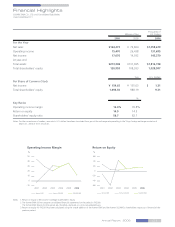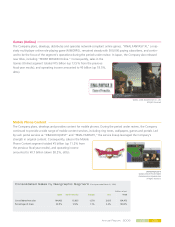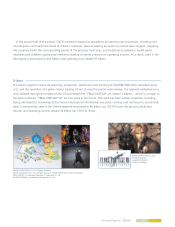Square Enix 2006 Annual Report Download - page 5
Download and view the complete annual report
Please find page 5 of the 2006 Square Enix annual report below. You can navigate through the pages in the report by either clicking on the pages listed below, or by using the keyword search tool below to find specific information within the annual report.
02 03
Annual Report 2006
achieve our goal of becoming the world’s leading company in
our chosen sphere.
2005: “Year Zero” for the “Video Game Industry”
In the twenty or so years since its emergence, the video game
industry has enjoyed extremely favorable growth. Although it
almost goes without saying that this growth was driven by the
advent of completely new and revolutionary content, at the
same time, another key ingredient has been the industry’s
unique structure.
In the industry’s early phase, video game console manufac-
turers developed and marketed both game consoles and game
software. The source of the growth of the industry was their
careful move recognizing the benefit of the network externality.
As a result, an enormous base of independent software developers
flourished. Each new generation of hardware produced by game
console manufacturers spawned a complete ecosystem comprising
software development and distribution channels. The ecosystem
rapidly grew to become a massive industry.
Simply stated, one could say that this industry developed not
as the “video game industry” but as the “game console industry.”
This setup has fostered a positive climate for risk-taking by game
software developers, and in some ways has been a comfortable
environment in which to grow.
However, in recent times several of the prerequisite conditions
necessary to maintain this ecosystem have begun to crumble.
From such physical media as read-only memory (ROM) cartridges
and DVDs, the industry is moving toward online networks. This
is not only altering the industry’s distribution structure but also
transforming the business model itself.
Furthermore, changes are occurring in the competitiveness of
game consoles. In particular, in terms of graphics capabilities,
game consoles that had enjoyed an overwhelming cost performance
advantage are now facing a raft of competitive challenges. On
the one hand, consumers have been oversupplied with features,
while on the other, general-use terminals have achieved a
remarkable jump in performance.
Of course, it is not the case that the conventional business
model has become generally obsolete. Apple Computer, Inc.’s
iPod and Nintendo Co., Ltd.’s NINTENDO DS demonstrate the
successful experience of the conventional model. What I am
referring to is the fact that it has become difficult for a single
game console manufacturer to sustain a market worth several
trillion yen. My point here is not to debate the fate of a particular
game console maker, but to explain the kind of problems briefly
that we must grapple with as a game software producer.
On reflection, if we focus our attention on the content itself,
over the past twenty years, millions of people around the world
have grown familiar with video games, while the assets we have
accumulated are vast. It would be fair to say that video games
have already become a recognized genre of entertainment.
If the ecosystem that has existed until now breaks down, the
content itself must become self-sustainable. In other words, our
basic cognizance of the operating environment is that a “video
game industry” in the true sense is beginning to take shape.
As well as being a significant opportunity, this juncture also
represents a huge challenge. We must examine at the most
fundamental level a whole array of points that—until now—
we have not needed to be directly involved with.
work is the Game.
thing plays Games.


















